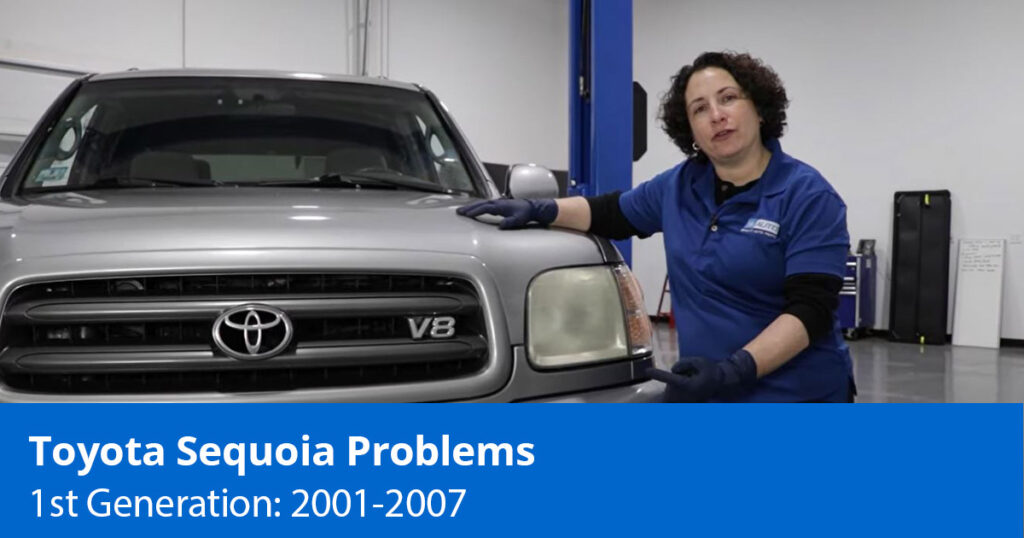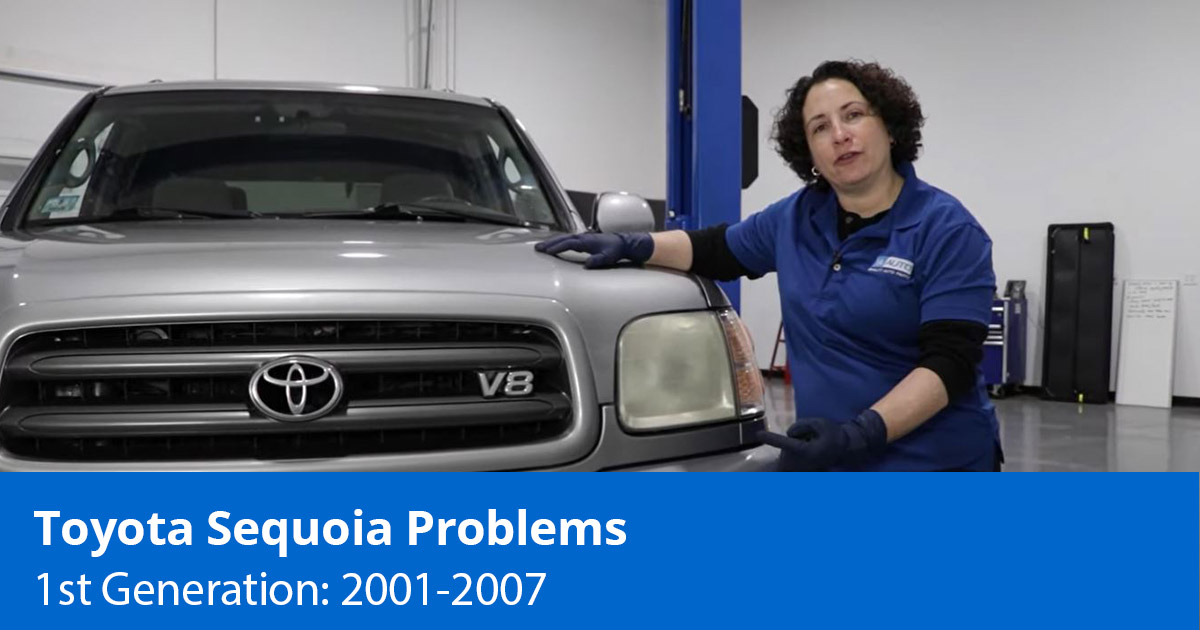
The Toyota Sequoia is a full-size SUV that has two generations and has existed since the 2001 model year. Here are the top 5 problems with the 1st gen Sequoia, years 2001 to 2007.

Common Toyota Sequoia Problems: 1st Generation (2001 to 2007)
1. Front Ball Joint Failure
Symptoms of Ball Joint Failure on the 1st Gen Toyota Sequoia
- Top or bottom ball joint shears off
How to Fix Ball Joint Failure
It depends on the model year, but there is a recall for this problem. Call a Toyota dealership with your VIN number to see about this issue.
2. Cracked Exhaust Manifold
Symptoms of an Exhaust Manifold
- Engine ticking that may disappear with the engine warmed up
Causes of a Cracked Exhaust Manifold
The engine ticking is from a cracked exhaust manifold.
How to Fix a Exhaust Manifold Problems on the 1st Gen Toyota Sequoia
Steps for Diagnosing a Cracked Exhaust Manifold on the 1st Gen Sequoia
- Start the Vehicle and Listen from the Fender
Start the vehicle. If able to listen from the fender well on the drive side with the vehicle parked. You may hear ticking noise.
- Spray the Exhaust Manifold with Soapy Water and Start the
with the engine cold, spray the exhaust manifold with soapy water. Start the vehicle. If there is an exhaust leak, the water will accumulate bubbles near the leak.
3. Oxygen (O2) Sensor Failure
Code P0051—not to be confused with codes P0171 or P0174, which have to do with a lean or rich running condition and indicate an engine fault like a vacuum leak or low fuel pressure—indicates a failure with the heater circuit. The problem is usually the O2 sensor on the 1st gen Sequoia.
How to Fix Oxygen O2 Sensor Failure
Replace the O2 sensor. The downstream is located after the second catalytic convertor, and the upstream is located close to the exhaust manifold.
4. Premature Front Brake Wear
Symptoms of Premature Front Brake Wear
- Front brakes wear out quickly
Causes of Premature Front Brake Wear
The brake calipers have quad-dual pistons that are known for seizing, especially if the Sequoia is normally driven in area that experiences inclement weather and related debris like snow and road salt. If the caliper pins are seizing, the brake pads will have trouble pressing in and out. The brake rotor may wear the pads prematurely if they are stuck.
5. Yaw Rate and Deceleration Sensor Failure
Symptoms of Yaw Rate and Deceleration Sensor Failure
- ABS or VCS light usually turns on at the same time and may flash
- Codes C1223 and C1244
Causes of Yaw Rate and Deceleration Sensor Failure
The signs above indicate a problem with the yaw or deceleration sensor. If the sensor is bent, the calibration will be off.
How to Fix Yaw Rate and Deceleration Sensor Failure
The deceleration sensor is located underneath the center console. Remove the bolts from the console and lift the console up. The sensor is gold and square.
Fix Your Own 1st Gen Sequoia
Learn how to do common repairs on the 1st gen Sequoia like the headlights, side view mirrors, window regulator, and tail lights with 1A Auto’s how-to videos.
1st Generation Toyota Sequoia Model Years
- 2001 Toyota Sequoia
- 2002 Toyota Sequoia
- 2003 Toyota Sequoia
- 2004 Toyota Sequoia
- 2005 Toyota Sequoia
- 2006 Toyota Sequoia
- 2007 Toyota Sequoia
Related Content
- Bad Ball Joint? [Expert Advice to Diagnose & Fix]
- How to Diagnose and Fix an Exhaust Manifold Leak
- P0141 Code On Your OBDII
- 8 Most Common Diagnostic Trouble Codes
- How Long Do Brakes Usually Last?
- When Should Brake Pads Be Replaced?
Shop 1st Gen Toyota Sequoia Parts
- Engine & Engine Management
- Interior
- Headlights & Lighting
- Steering & Suspension
- Fuel & Emissions
- Brakes & Wheel Bearing



